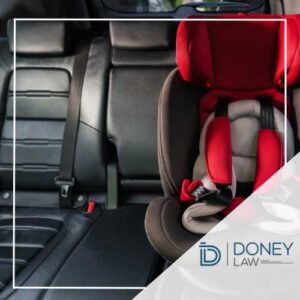
Parents prioritize their children’s safety and well-being. However, many parents may be putting their children at risk and not even realize it.
The state has specific laws and requirements for child safety seats. Failing to comply with these puts your child at risk and may result in additional consequences for parents.
We understand that the laws can be confusing at Doney Law and are here to help. Here, you can learn more about Miami’s child safety seat laws. Knowing these is the first step to ensuring your child’s safety.
If you have questions or need legal assistance, contact our car accident lawyers in Miami.
Age and Weight Requirements
Adhering to Oklahoma’s child safety seat laws requires that you know the age and weight requirements. These regulations are designed to ensure that children are properly restrained based on their developmental stages, significantly reducing the likelihood of injury in the event of a collision.
Infants and Toddlers
For infants and toddlers, Oklahoma law mandates using a rear-facing car seat until they reach the age of two or exceed the manufacturer’s weight and height limits for the car seat. Rear-facing car seats are designed to support infants’ head, neck, and spine in case of an accident.
The law specifies that children under two should be placed in these seats to provide maximum protection. If you need help properly installing a rear-facing car seat, seek assistance from the local police or fire department.
Young Children
Once children outgrow their rear-facing car seats, typically after their second birthday, they should transition to a forward-facing car seat with a harness. According to Oklahoma law, this forward-facing seat should be used until the child reaches at least four years of age.
The harness is crucial as it restrains the child during a crash, distributing the force of the impact over the body’s strongest parts. It is recommended that the child continue using a forward-facing car seat until the child surpasses the seat’s maximum weight and height limits, as specified by the manufacturer.
Older Children
Oklahoma law requires a booster seat for children aged four to eight. Booster seats are essential for lifting the child so that the vehicle’s seat belt fits correctly over the stronger parts of the body, specifically the chest and pelvis.
The law states that children in this age range should use a booster seat until they are either eight years old, weigh at least 80 pounds, or are taller than 4 feet 9 inches. Parents need to recognize that these guidelines are in place to provide the best possible protection during travel.
Seat Belt Use
Once a child outgrows the requirements for a booster seat, Oklahoma law permits them to use a regular seat belt. However, the seat belt must fit properly, with the lap belt lying snugly across the upper thighs and the shoulder belt crossing the chest and shoulder.
Children are typically ready for a seat belt when they can sit upright against the vehicle seat back with their knees bent over the edge of the seat without slouching.
Parents can ensure their children travel safely and legally by understanding and complying with these age and weight requirements. Consulting with a car accident lawyer in Miami is always a prudent choice for continued safety and up-to-date legal guidance.
Proper Installation and Usage
Properly installing and using child safety seats is necessary to ensure maximum protection for young passengers. Even the best car seat will not offer adequate protection if incorrectly installed or used.
The following guidelines will help ensure your child’s safety seat provides the best possible protection during travel.
Installation Tips
Each type of car seat has specific installation instructions that must be followed carefully. Read the car seat and your vehicle’s owner manual for compatibility and installation instructions.
Most car seats can be installed using the vehicle’s seat belt or the LATCH (Lower Anchors and Tethers for Children) system. Ensure the car seat is securely fastened with no more than one inch of movement from side to side or front to back.
The car seat should also be positioned at the correct angle, particularly for rear-facing seats, to keep the baby’s airway open. If in doubt, consult a certified child passenger safety technician for guidance.
Harnessing Tips
A properly adjusted harness is crucial for the car seat to function correctly. The harness straps should be snug and positioned at or just below the child’s shoulders for rear-facing seats and at or above the shoulders for forward-facing seats.
The chest clip should be aligned with your child’s armpits to keep the harness straps properly positioned. Wear your child in thin, snug clothing to ensure the harness fits them securely. Thick jackets can create slack in the harness, reducing its effectiveness.
Common Installation Mistakes
Common installation mistakes include using an expired car seat, placing the car seat in the wrong direction, or failing to use a top tether for forward-facing seats. Others might not secure the seat belt or LATCH system tightly enough or could leave the harness too loose.
Another frequent error is not adjusting the car seat according to the child’s growth. Check the car seat regularly for recalls and replace any seat involved in a moderate to severe crash.
Using the Seat Correctly Every Trip
Consistency is critical for child passenger safety. Always verify that the car seat is secure and that the harness is correctly adjusted before every trip. Encourage children to sit correctly in car seats without moving the straps or buckles.
Educate your older children about the importance of sitting still and keeping the harness snug throughout the journey.
Ensuring a Safe Journey for Your Child
Your child’s safety while traveling depends on the proper selection, installation, and usage of their car seat. Understanding the stages from rear-facing seats to booster seats and finally to seat belts is crucial in providing the best protection tailored to your child’s development.
Adhere to manufacturer guidelines and frequently check for car seat recalls. This helps ensure your child’s car seat performs optimally.
If you are involved in an accident or have questions, our experienced Oklahoma injury attorneys are here to help. Contact our office today.





